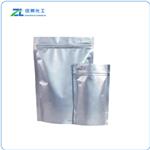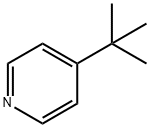4-tert-Butylpyridine: Applications in ssDSSC Interface Tuning and PSC Efficiency/Stability
4-tert-Butylpyridine (C₉H₁₃N), molecular weight 135.21, CAS Registry Number 3978-81-2, is an organic compound also known as p-tert-butylpyridine. At room temperature, it exists as a transparent, colorless to slightly yellow liquid with a density of 0.923 g/cm³, a boiling point of 196–197°C, and a flash point of 67°C. This substance is used as an electrolyte additive in dye-sensitized solar cells, enhancing the cell's open-circuit voltage and photovoltaic conversion efficiency (as reported in literature achieving 10.68% PCE). 4-tert-Butylpyridine is a flammable liquid that irritates skin and eyes. It must be stored sealed in a light-protected, well-ventilated, dry location. Wear protective equipment during handling.

Investigation of the Function of 4-tert-Butyl Pyridine for Interface Energy Level Adjustment
Nanostructured dye-sensitized solar cells (DSCs) have become a promising technology because of their cost-effective fabrication. On the basis of the development through decades, a world record power conversion efficiency of 13% has been reached by Grätzel et al. for the electrolyte-based DSCs. In spite of different device architectures, two crucial additives are commonly employed for interfacial modifications in DSC to obtain the appropriate device performance, namely, 4-tert-butylpyridine and lithium bistrifluoromethylsulfonyl imide (Li-TFSI). Even though t-BP is an important additive for improving the ssDSSC performance, the operating mechanism of 4-tert-butylpyridine still remains poorly understood. It has been suggested that t-BP may have two significant roles for DSC devices: (1) similar to Li-TFSI, t-BP tends to adsorb onto the TiO2 surface and to protect the area uncovered by dye molecules and therefore to inhibit the free charge carrier recombination; (2) the molecular dipole moment of 4-tert-butylpyridine leads to a favorable upward shift of the CB of TiO2. In ssDSSC devices, the open circuit voltage, Voc, is determined by the energy-level difference between the quasi-Fermi level in the mesoporous TiO2 electrode and the quasi-Fermi level in the HTM layer.[1]
In summary, the mechanism how 4-tert-Butylpyridine as an additive influences the ssDSSC photovoltaic performance was systematically investigated on samples with altered t-BP concentration. The results from the HAXPES measurements highly agree with the solar cell characterization measurements, which provides a direct experimental evidence showing that the observed improvements in photovoltage upon the addition of t-BP is due to the molecular dipole moment of 4-tert-Butylpyridine resulting in a beneficial upward shift of the CB of the dye-sensitized mesoporous TiO2 electrode. Moreover, the adsorbed t-BP molecules on TiO2 surface efficiently inhibit charge recombination leading to a positive effect on photovoltaic performance. In addition, DFT calculations were performed to visualize the adsorption of t-BP on TiO2 surface. In agreement with the HAXPES results, the surface dipole changes the work-function of the surface in the favorable direction. Hence, this study unveils the functioning mechanism of 4-tert-Butylpyridine as an interfacial additive in ssDSSC devices with solid experimental evidence and predictive theoretical insights. We think that this mechanism is rather general and provides possibilities for future improvements of hybrid organic/inorganic solar cells.
Incorporating 4-tert-Butylpyridine in an Antisolvent
Organometal halide perovskites are attractive materials for solar cells because of their ease of fabrication, panchromatic absorption of sunlight, and long carrier diffusion length. Since they were reported by Miyasaka et al. in 2009 with a power conversion efficiency (PCE) of 3.8%, perovskite solar cells (PSCs) have now achieved a significant efficiency of over 22%. Herein, to avoid these problems, the method of adding 4-tert-butylpyridine (tBP) in an antisolvent was adopted. A gradient heterojunction structure was formed through the addition of tBP in the antisolvent to enhance the perovskite efficiency and stability. On the one hand, 4-tert-Butylpyridine suppressed the nucleation of CH3NH3PbI3 by forming an intermediate adduct. The cooperation between the nitrogen atom on tBP and the Pb2+ on CH3NH3PbI3 resulted in smooth perovskite films with fewer defects and larger grains, enabling the preparation of devices with superior performance. By doing this, an effective PCE of 17.41% was achieved. On the other hand, tBP was employed as a surface modification agent to augment the hydrophobicity of CH3NH3PbI3. As a result, the devices with 4-tert-Butylpyridine treatment exhibited slower deterioration rates with the PCE remaining over 89% after 30 days.[2]
In summary, we formed a high-quality CH3NH3PbI3 film through the addition of 4-tert-Butylpyridine in the antisolvent. To further prove the impact of tBP treatment on the crystallization process, in situ optical microscopy and XRD were used to prove that tBP significantly suppressed the perovskite nucleation by forming the intermediate phase:-CH3NH3I–PbI2–DMSO·tBPx. Besides, steady-state PL and TRPL showed that the method of the addition of tBP in the antisolvent could achieve higher quality and charge-transfer films than the addition of tBP in the precursor solution and the pure perovskite. The derived contact angles demonstrated that hydrophobicity of the perovskite could be easily increased by incorporation of 4-tert-Butylpyridine. At last, an effective PCE of 17.41% was developed via tBP treatment, and the high efficiency device could maintain over 89% of the initial PCE after 30 days at room temperature with tBP treatment.
4-tert-Butylpyridine Improves the Thermal Stability of Perovskite Solar Cells
The recipe of Spiro-MeOTAD–based charge transfer layer so far in PSCs has little difference from that in solid-state dye-sensitized solar cells (DSSCs). Admittedly, simply replacing Spiro-MeOTAD with commercially available polymers or synthesizing small molecules is a practical way to overcome this issue. Nevertheless, the Spiro-MeOTAD with two main additives of LiTFSI and 4-tert-Butylpyridine is still the first choice among other HTLs in the state-of-art devices because higher power conversion efficiency is obtained from the Spiro-MeOTAD–based PSCs. Since LiTFSI and tBP have been considered to be problematic, additives alternative to LiTFSI and/or 4-tert-Butylpyridine have been studied to enhance thermal stability. It was reported that many compounds can be used as additives, from small molecules to polymers such as poly(9-vinylcarbazole) (PVK). On the perspective of stability, the passivation benefits blocking the migration of ions from perovskite to Spiro-MeOTAD film and suppressing the diffusion of LiTFSI from Spiro-MeOTAD to perovskite, as well as controlling the underlying chemical reaction of tBP with perovskite surface. However, the pain point remains because of conductivity loss by the diffusion of lithium cation triggered by the presence of coadditive tBP and aggregation caused by evaporation of 4-tert-Butylpyridine.[3]
In conclusion, we have solved the issue of instability of PSCs employing Spiro-MeOTAD at 85 °C. First, the effects of additives included in the Spiro-MeOTAD films on photovoltaic performance and surface morphology were systematically investigated, from which we found that thermal instability was caused by coexistence of 4-tert-Butylpyridine and LiTFSI. Moreover, the perovskite/HTL interface was found to be closely related to the thermally induced performance failure, where the LiTFSI in the Spiro-MeOTAD film strongly interacted with the underneath perovskite surface. Such an interaction between LiTFSI and the perovskite surface led to the formation of aggregates of LiTFSI upon thermal stress, which was facilitated by diffusive tBP residues within the Spiro-MeOTAD film, leading to perovskite decomposition and serious deterioration of the photovoltaic performance. Removal of 4-tert-Butylpyridine in the Spiro-MeOTAD films is thus essential to improving the thermal stability. We developed a thermal degassing method to remove the residual tBP left in the Spiro-MeOTAD films, and a two-step degassing procedure at 65 and 85 °C eventually achieved 90% of the initial PCE of the n-i-p structured PSCs employing a Spiro-MeOTAD layer after 1000 h aging at 85 °C, which is among the highest values.
References
[1]Yang L, Lindblad R, Gabrielsson E, Boschloo G, Rensmo H, Sun L, Hagfeldt A, Edvinsson T, Johansson EMJ. Experimental and Theoretical Investigation of the Function of 4- tert-Butyl Pyridine for Interface Energy Level Adjustment in Efficient Solid-State Dye-Sensitized Solar Cells. ACS Appl Mater Interfaces. 2018 Apr 11;10(14):11572-11579. doi: 10.1021/acsami.7b16877. Epub 2018 Mar 30. PMID: 29560716.
[2]Wu YH, Shi XQ, Ding XH, Ren YK, Hayat T, Alsaedi A, Ding Y, Xu P, Dai SY. Incorporating 4-tert-Butylpyridine in an Antisolvent: A Facile Approach to Obtain Highly Efficient and Stable Perovskite Solar Cells. ACS Appl Mater Interfaces. 2018 Jan 31;10(4):3602-3608. doi: 10.1021/acsami.7b16912. Epub 2018 Jan 17. PMID: 29313326.
[3]Liang X, Ming Y, Lee SH, Fu G, Lee SU, Kim TI, Zhang H, Park NG. Degassing 4-tert-Butylpyridine in the Spiro-MeOTAD Film Improves the Thermal Stability of Perovskite Solar Cells. ACS Appl Mater Interfaces. 2024 Jun 26;16(25):32147-32159. doi: 10.1021/acsami.4c00631. Epub 2024 Jun 12. PMID: 38864112.
See also
Lastest Price from 4-TERT-BUTYLPYRIDINE manufacturers

US $50.00/kg2025-04-21
- CAS:
- 3978-81-2
- Min. Order:
- 1kg
- Purity:
- 99
- Supply Ability:
- 5000

US $15.00-10.00/KG2021-07-02
- CAS:
- 3978-81-2
- Min. Order:
- 1KG
- Purity:
- 99%+ HPLC
- Supply Ability:
- Monthly supply of 1 ton


